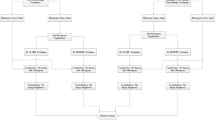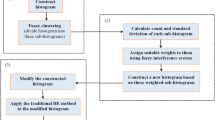Abstract
The research work proposes a novel triangular fuzzy membership (TFM) function-based contrast limited adaptive histogram equalization (CLAHE) for biometric image enhancement. Biometric images have wide applications in the areas of verification and authentication systems. For accurate identification and verification, pre-processing of captured biometric images becomes essential. When the region of interest is smaller than the original image, a variation of histogram equalization called adaptive histogram equalization (AHE) is used. AHE enhances contrast of images by considering local regions. Along with local contrast, noise in those regions also get amplified by using AHE. This amplification of noise can be resolved by applying a contrast limited AHE (CLAHE) which limits the contrast in the enhanced local regions by clipping the histogram at a pre-fixed limit. CLAHE yields good results by limiting the contrast and enhancing local regions, but it is image invariant since it uses pre-determined clip limit for limiting contrast. The proposed research work TFM-CLAHE puts forward the idea of image variant, automatic clip value determinant algorithm for enhancement. The algorithm employs triangular fuzzy membership function to determine clip-limit and limits contrast by clipping the histogram at the computed clip-level. TFM function computes the clipping parameter by considering intensities of pixels. The computed fuzzy clip-limit overrides the pre-defined limit. Consequently, the clipping parameter varies according to the image under consideration and yields better enhancement results. The proposed work is experimented on multimodal biometric images acquired from Chinese Academy of Science, Institute of Automation Iris, Face and Fingerprint databases. TFM-CLAHE computes appropriate clipping limit for each of these heterogenous images. The results of the proposed work are evaluated on the grounds of images’ average information content, mean square error, peak signal noise ratio, natural image quality evaluator, no-reference free energy based robust metric, blind image quality measure of enhanced images and no reference quality metric for contrast distortion. The results show good enhancement and these are compared with existing conventional image enhancement techniques.






















Similar content being viewed by others
References
Pratt, W. K. (2007). Digital image processing: PIKS inside (4th ed.). New York: Wiley.
Su, X., Fang, W., Shen, Q., & Hao, X. (2013). An image enhancement method using the quantum-behaved particle swarm optimization with an adaptive strategy. Mathematical Problems in Engineering, 2013, 3.
Gu, K., Zhai, G., & Yang, X. (2014). Automatic contrast enhancement technology with saliency preservation. IEEE Transactions on Circuits and Systems for Video Technology, 25, 1480–1494.
Ravichandran, C. G., & Magudeeswaran, V. (2012). An efficient method for contrast enhancement in still images using histogram modification framework. Journal of Computer Science, 8(5), 775–779.
Kim, Y. (1997). Contrast enhancement using brightness preserving bi-histogram equalization. IEEE Transactions on Consumer Electronics, 43(1), 1–8.
Wan, Y., Chen, Q., & Zhang, B.-M. (1999). Image enhancement based on equal area dualistic sub-image histogram equalization method. IEEE Transactions on Consumer Electronics, 45(1), 68–75.
Chen, S. D., & Ramli, A. R. (2003). Minimum mean brightness error bi-histogram equalization in contrast enhancement. IEEE Transactions on Consumer Electronics, 49(4), 1310–1319.
Chen, S. D., & Ramli, A. R. (2003). Contrast enhancement using recursive mean-separate histogram equalization for scalable brightness preservation. IEEE Transactions on Consumer Electronics, 49(4), 1301–1309.
Abdullah-Al-Wadud, M., Kabir, M. H., Dewan, M. A. A., & Chae, O. (2007). A dynamic histogram equalization for image contrast enhancement. IEEE Transactions on Consumer Electronics, 53(2), 593–600.
Kong, N. S. P., & Ibrahim, H. (2008). Color image enhancement using brightness preserving dynamic histogram equalization. IEEE Transactions on Consumer Electronics, 54(4), 1.
Magudeeswaran, V., & Fensia Singh, J. (2017). Contrast limited fuzzy adaptive histogram equalization for enhancement of brain images. International Journal of Imaging Systems and Technology, 27, 98–103.
Chandra, E., & Kanagalakshmi, K. (2011). Noise elimination in fingerprint image using median filter. International Journal of Advanced Networking and Application, 2(6), 950–955.
Maurya, L., Mahapatra, P. K., & Kumar, A. (2017). A social spider image fusion approach for contrast enhancement and brightness preservation. Applied Soft Computing, 52, 575–592.
Jenifer, S., Parasuraman, S., & Kadirvelu, A. (2016). Contrast enhancement and brightness preserving of digital mammograms using fuzzy clipped contrast limited adaptive histogram equalization algorithm. Applied Soft Computing, 42, 167.
Magudeeswaran, V., & Ravichandran, V. (2013). Fuzzy logic based histogram equalization for image contrast enhancement. Mathematical Problems in Engineering, 2013, 1.
Gui, Z., & Liu, Y. (2011). An image sharpening algorithm based on fuzzy logic. Optik, 122, 697–702.
Majumdar, J., & Kumar, S. (2014). Modified CLAHE: an adaptive algorithm for contrast enhancement of arial, medical and underwater images. International Journal of Computer Engineering and Technology, 5(11), 32–47.
Wei, Z., Lidong, H., Jun, W., & Zebin, S. (2015). Entropy maximization histogram modification scheme for image enhancement. IET Image Processing, 9, 226–235.
Tang, J. R., & Mat Isa, N. A. (2014). Adaptive image enhancement based on bi-histogram equalization with a clipping limit. Computers and Electrical Engineering, 40(8), 86–103.
Zhuang, L., & Guan, Y. (2017). Image enhancement via subimage histogram equalization based on mean and variance. Computational Engineering and Neuroscience, 2017, 1.
Saxena, K., Pokhriyal, A., & Lehri, S. (2014). SCIENCE: Soft computing image enhancement for contrast enhancement. International Journal of Advanced Computing, 47(1), 1.
Sree Vidya, B., & Pugazhenthi, D. (2013). Multiple biometric security in cloud computing. International Journal of Advanced Research in Computer Science and Engineering, 3(4), 1.
Sree Vidya, B., & Pugazhenthi, D. (2015). Multimodal biometric cryptographic based in cloud environment to enhance information security. International Conference World Academy of Science Engineering and Technology, 2, 1.
Wang, Z., & Tao, J. (2006). A fast implementation of adaptive histogram equalization. In 8th international conference on signal processing (Vol. 2).
Hossain, F., & Alsharif, M. R. (2007). Image enhancement based on logarithmic transform coefficient and adaptive histogram equalization. International Conference on Convergence Information Technology, 1, 1439–1444.
Reza, A. M. (2004). Realization of the contrast limited adaptive histogram equalization (CLAHE) for real-time image enhancement. Journal of VLSI Signal Processing Systems for Signal, Image and Video Technology, 38(1), 35–44.
Hitam, M. S., Awalludin, E. A., Yussof, W. N. J. H. W., & Bachok, Z. (2013). Mixture contrast limited adaptive histogram equalization for underwater image enhancement. In International conference on computer applications technology (ICCAT) (pp. 1–5).
Ooi, C. H., Pikkong, N. S., & Ibrahim, H. (2009). Bi-histogram equalization with a plateau limit for digital image enhancement. IEEE Transactions on Consumer Electronics, 55(4), 2072–2080.
Liang, K., Ma, Y., Xie, Y., Zhou, B., & Wang, R. (2012). A new adaptive contrast enhancement algorithm for infrared images based on double plateaus histogram equalization. Infrared Physics and Technology, 55, 309–315.
Chang, Y., & Chang, C. (2010). A simple histogram modification scheme for contrast enhancement. IEEE Transactions on Consumer Electronics, 56(2), 737–742.
Moorthy, A. K., & Bovik, A. C. (2011). Blind image quality assessment: from natural scene statistics to perceptual quality. IEEE Transactions on Image Processing, 20(12), 3350–3364.
Mittal, A., Soundararajan, R., & Bovik, A. C. (2013). Making a completely blind image quality analyzer. IEEE Signal Processing Letters, 20(3), 209–212.
Sree Vidya, B., & Chandra, E. (2018). Multimodal biometric hashkey cryptography based authentication and encryption for advanced security in cloud. Biomedical Research, 5, 506–516.
Gu, K., Lin, W., & Zhai, G. (2016). No-reference quality metric of contrast-distorted images based on information maximization. IEEE Transactions on Cybernatics, 47, 4559.
Gu, K., & Tao, D. (2017). Learning a no-reference quality assessment model of enhanced images with big data. IEEE Transactions on Neural Networks and Learning Systems, 29, 1301.
Gu, K., Zhai, G., Yang, X., & Zhang, W. (2015). Using free energy principle for blind image quality assessment. IEEE Transactions on Multimedia, 17(1), 50–63.
Author information
Authors and Affiliations
Corresponding author
Ethics declarations
Conflict of interest
The authors declare that there are no competing interests.
Additional information
Publisher's Note
Springer Nature remains neutral with regard to jurisdictional claims in published maps and institutional affiliations.
Rights and permissions
About this article
Cite this article
Sree Vidya, B., Chandra, E. Triangular Fuzzy Membership-Contrast Limited Adaptive Histogram Equalization (TFM-CLAHE) for Enhancement of Multimodal Biometric Images. Wireless Pers Commun 106, 651–680 (2019). https://doi.org/10.1007/s11277-019-06184-6
Published:
Issue Date:
DOI: https://doi.org/10.1007/s11277-019-06184-6




